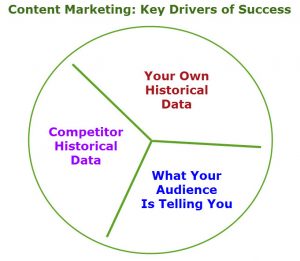
One of the dirty little secrets of most Content Marketing efforts today is that they are largely
unsuccessful. Tremendous amounts of time, effort and money are spent, all resulting in little or no significant results.
A post-mortem on most of them will reveal that, in reality, there was no real strategy behind these efforts in the first place. And one of the things that becomes a real obstacle to effective strategizing is a lack of accurate documentation.
Simply put, marketing goes astray when you don’t work from a plan, from day one, and document everything — which is what we want to cover in this second series on Content Marketing. (You can find the first one in the series here.)
Content Marketing: Document, Document, Document!
So what needs to be documented? Yes, your overall strategy, as it evolves. Your Content Marketing game plan WILL evolve over time, so you have to have someplace where you can document what was originally planned out (and why) as well as noting changes, as they are made, along the way.
Communication Channels: Your documentation efforts should involve consideration of the various “channels” or ways of communicating — Facebook, Twitter, press releases, blog writing, videos, etc. Each should be noted as a separate entity, as different channels require different approaches.
KW Research: Of course, any content posted should be targeted so that it can be ranked for specific user searches, in order to get found. All of your KW research should be included as a part of your ongoing documentation.
Content Types Needed: What specific content pieces will be needed? In what format — A PDF case study, a podcast in mp3 format, an infographic — Be sure to think about, and note, the style(s) that will be needed, length, tone of voice and other requirements.
Editorial Calendar: Pushing out a lot of content to various channels can drive you crazy unless you get organized. An “editorial calendar” is exactly that, a calendar where you establish specific dates as deadlines for getting your content produced, reviewed and approved, and finally published. And as other people are going to need to see it, the calendar should be sharable, editable or at least viewable by others on your team.
Collaboration Tools: Speaking of collaboration, you are going to need to decide what types of collaboration tools (Slack, Skype, G Docs, etc.) you are going to need. Make sure that you get that set up ahead of time, and that team members have access to them, and with the proper level of access.
Timelines: As you flesh out your editorial calendar, pay special attention to critical milestones for different phases of your campaign. For example, if you are trying to hit influencers for winter holiday-related promotions, this needs to be in place well beforehand, perhaps the early Fall or even late Summer.
Just Who Is Responsible For All Of This?
Establishing responsibility is a key to successful marketing, including Content Marketing. Don’t wait until things are underway to make decisions about who is going to be responsible for what —
EVERY piece of content you put out there (regardless of channel) must be approved — and ONE person should be given this most-important-of-all-tasks, or else you risk putting out an inconsistent message. Something that might pass muster for one person might be rejected by another, so choose this key team member carefully. They should be fully versed in your company culture and be passionate about communicating your brand message in a consistent way, over all channels.
Your “Approver” should be approving…
- WHO will prepare content
- WHAT keywords will be targeted
- HOW special content will be produced (such as videos, research studies, seminars, webinars)
Time For A Reality Check?
During this “pre-roll-out” phase, there are some things you need to seriously think about — or else you will fail —
Don’t Overdo It — Don’t attempt to eat the whole apple at once. Better to do a few things and nail it than attempt to launch a rocket to the moon and fail. Limit your focus to what you can realistically handle, get that right, then and then move on to another phase.
Money Talks — Really, do you have the time, personnel and financial resources to launch a Content Marketing campaign? One invariable rule of Content Marketing campaigns is that they usually end up taking more of your time and money than you might have estimated in the beginning. Make sure that you (and your staff) can handle the load. If you are unsure, scale back — you can always add to your efforts later, as long as what you have done so far has been solid.
Realistic Timeframes — It is not uncommon for some CM campaigns to typically run for 6 months to a year. Are you ready for the long haul, or are you looking for a quick fix? Quick fixes usually don’t “fix” the problem at all.
Mistakes — Everyone makes them, I have and you will too. But if you are documenting everything then you can document your mistakes — what happened, and more importantly, why — so that in the future you won’t make them again. And believe me, you can’t run just one CM campaign and retire on the earnings. Your documentation on the current campaign will help you to prepare for the next one.
Let’s Look At The Larger Picture
Here’s a look at how everything fits together at this point.
There are three key drivers of success for your CM campaign at this stage of the game:
Your historical data/metrics – How you are doing now (We’ll talk about doing a content audit later.)
The data/metrics of your competitors – How are they doing?
What your audience is telling you that they expect/need/want/are looking for.
What needs to happen is that you need to use all of the above to develop a set of your most critical metrics for success of your CM campaign.
Once you know that, you are going to produce different types of content and monitor their performance against those metrics.
Are you moving the needle? You will adjust, in real time, your strategies going forward, to move the needle further and more effectively.
“Sheesh, it sure looks like I’ll need a lot of data!”
Yep, you got that right — And it’s SO important that it will be the subject of the next few articles, so stay tuned as we really dig deep into this.
So stay tuned for future installments …We hope you like them and find them useful!….
These articles first appeared on LinkedIN Pulse, and have been modified with permission by the original author.





